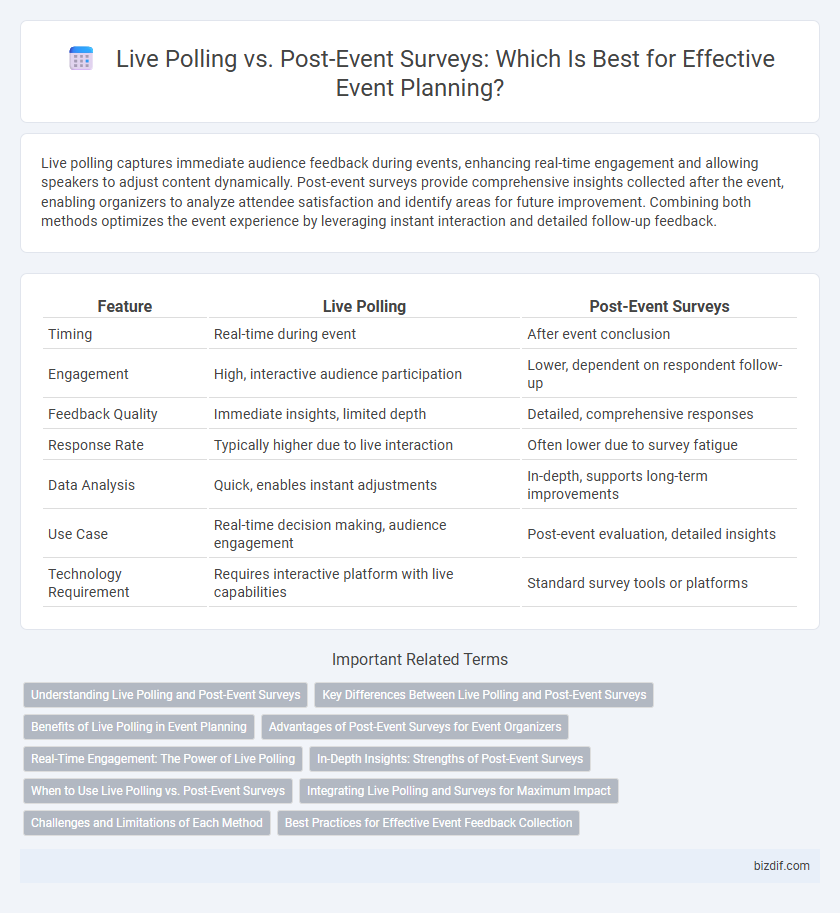Live polling captures immediate audience feedback during events, enhancing real-time engagement and allowing speakers to adjust content dynamically. Post-event surveys provide comprehensive insights collected after the event, enabling organizers to analyze attendee satisfaction and identify areas for future improvement. Combining both methods optimizes the event experience by leveraging instant interaction and detailed follow-up feedback.
Table of Comparison
| Feature | Live Polling | Post-Event Surveys |
|---|---|---|
| Timing | Real-time during event | After event conclusion |
| Engagement | High, interactive audience participation | Lower, dependent on respondent follow-up |
| Feedback Quality | Immediate insights, limited depth | Detailed, comprehensive responses |
| Response Rate | Typically higher due to live interaction | Often lower due to survey fatigue |
| Data Analysis | Quick, enables instant adjustments | In-depth, supports long-term improvements |
| Use Case | Real-time decision making, audience engagement | Post-event evaluation, detailed insights |
| Technology Requirement | Requires interactive platform with live capabilities | Standard survey tools or platforms |
Understanding Live Polling and Post-Event Surveys
Live polling facilitates real-time audience engagement by collecting immediate feedback during events, allowing organizers to adjust content and interaction dynamically. Post-event surveys capture detailed insights after the event, providing comprehensive data on attendee satisfaction and areas for improvement. Both tools serve essential roles in event planning by enhancing understanding of participant preferences and measuring event success effectively.
Key Differences Between Live Polling and Post-Event Surveys
Live polling captures real-time attendee feedback during events, enabling immediate interaction and adjustment, while post-event surveys collect reflective responses after the event, offering comprehensive insights for future planning. Live polling typically features short, dynamic questions with instant result displays, enhancing engagement and participant involvement. Post-event surveys provide more detailed data through longer question formats, allowing event planners to analyze overall satisfaction, content effectiveness, and improvement opportunities over time.
Benefits of Live Polling in Event Planning
Live polling enhances attendee engagement by providing real-time feedback and fostering interactive participation during events. It allows organizers to make immediate adjustments based on audience responses, improving event relevance and satisfaction. Unlike post-event surveys, live polling captures authentic reactions and generates valuable data for on-the-spot decision-making and dynamic content tailoring.
Advantages of Post-Event Surveys for Event Organizers
Post-event surveys provide detailed feedback on attendee satisfaction, enabling event organizers to identify strengths and areas for improvement with precision. They offer comprehensive data on overall event experience, including logistics, content quality, and speaker effectiveness, which supports strategic planning for future events. This method facilitates in-depth analysis through customizable questions and open-ended responses, enhancing the ability to make data-driven decisions that boost event success.
Real-Time Engagement: The Power of Live Polling
Live polling drives real-time engagement by capturing audience feedback instantly, fostering active participation during events. Unlike post-event surveys, live polls enable dynamic interaction and immediate insights that can guide event flow and content adjustments. This instantaneous data collection enhances attendee satisfaction and decision-making efficiency for event planners.
In-Depth Insights: Strengths of Post-Event Surveys
Post-event surveys offer in-depth insights by allowing attendees to reflect thoughtfully on their experiences, providing comprehensive feedback about different event elements. These surveys capture detailed qualitative data and identify long-term impacts on attendee satisfaction and behavior. The extended response time enables organizers to analyze trends and areas for improvement more thoroughly than real-time live polling.
When to Use Live Polling vs. Post-Event Surveys
Live polling is ideal during events to capture real-time audience feedback and increase engagement, making it perfect for keynote sessions, workshops, or panel discussions. Post-event surveys are more effective for collecting detailed insights on overall event satisfaction, logistics, and participant experiences once the event has concluded. Choosing between live polling and post-event surveys depends on whether immediate interaction or comprehensive evaluation is the primary goal.
Integrating Live Polling and Surveys for Maximum Impact
Integrating live polling with post-event surveys enhances audience engagement by capturing real-time feedback and deeper insights after the event. Live polling boosts interaction and gauges immediate attendee sentiment, while post-event surveys provide comprehensive data for evaluating overall satisfaction and improving future events. Combining these tools ensures a holistic understanding of attendee experience, optimizing event planning strategies and driving actionable outcomes.
Challenges and Limitations of Each Method
Live polling offers immediate audience engagement but faces challenges such as potential technical glitches and limited response depth due to time constraints. Post-event surveys allow for comprehensive feedback collection yet suffer from low response rates and delayed insights, which can hinder timely improvements. Balancing real-time interaction and detailed analysis requires addressing these inherent limitations in both methods to optimize event evaluation.
Best Practices for Effective Event Feedback Collection
Live polling enhances real-time audience engagement and provides immediate insights during events, enabling prompt adjustments and increased interaction. Post-event surveys offer comprehensive feedback on attendee experiences, allowing organizers to analyze data for future improvements and strategic planning. Combining both methods ensures a holistic approach to feedback collection, optimizing event success through timely and detailed responses.
Live polling vs Post-event surveys Infographic

 bizdif.com
bizdif.com